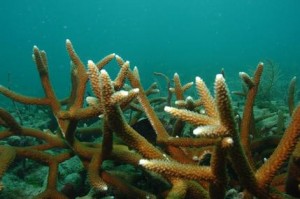http://www.palmbeachpost.com/news/palm-beach-fends-off-coral-protections-favoring-beach-191244.html
By Paul Quinlan Palm Beach Post Staff Writer Special thanks to Reef Rescue of Palm Beach
Updated: 10:01 p.m. Friday, Jan. 22, 2010 Posted: 3:10 p.m. Friday, Jan. 22, 2010
PALM BEACH — Endangered coral flourishing in rare abundance off the coast of Palm Beach will not receive the added federal protections that a reef conservation group sought, the National Marine Fisheries Service said today.
The thicket of staghorn coral — the striking species recognizable for its bronze, white-tipped branches — is believed to be the northernmost known colony, covering 2,400 square feet of reef just offshore from Palm Beach’s exclusive Bath & Tennis Club.
The decision is a victory for the Town of Palm Beach, which fought the request filed by the nonprofit group Palm Beach County Reef Rescue. Reef Rescue wanted a vast underwater area along Palm Beach County declared “critical habitat” for the coral — a change that would add hurdles to the town’s future efforts to pump new sand onto its eroding beaches.
“We’re disappointed,” said Reef Rescue Director Ed Tichenor, adding that the only explanation was that the “the Town of Palm Beach has influence.”
Town of Palm Beach Manager Peter Elwell applauded the decision as scientifically sound. “We’re pleased with the decision and continue to believe that it is based on the best science available,” Elwell said.
The National Marine Fisheries Service said protections established in November 2008 that run from the Florida Keys to the Boynton Beach Inlet are enough to meet conservation goals.
A further extension north could take years to study, the agency said, given its current workload.
“The current designation took us two years to complete, and right now we just think there are higher priority conservation measures that can be undertaken,” said resource specialist Jennifer Moore.
Tichenor rejected that argument, saying that previous study had already found large staghorn coral colonies north of Boynton Beach.
He cited a February 2009 letter from Florida Department of Environmental Protection Secretary Mike Sole recommending the protection be extended north to the Lake Worth Inlet.
“The purpose of our petition was to get them to correct their mistake,” said Tichenor. “These colonies on Bath and Tennis Reef are exactly where the Department of Environmental Protection told them they were.”
Tichenor said his group is considering a lawsuit.
Staghorn coral won protection under the Endangered Species Act after it virtually disappeared, declining 97 percent since the 1970s.
But the coral has rebounded along South Florida’s coastline, thanks largely to a string of quiet hurricane seasons.
A critical habitat designation adds an extra layer of federal protection to the endangered coral species. For example, it would require the Town of Palm Beach to take extra measures to protect areas where the coal could grow when pumping sand onto its beaches.
